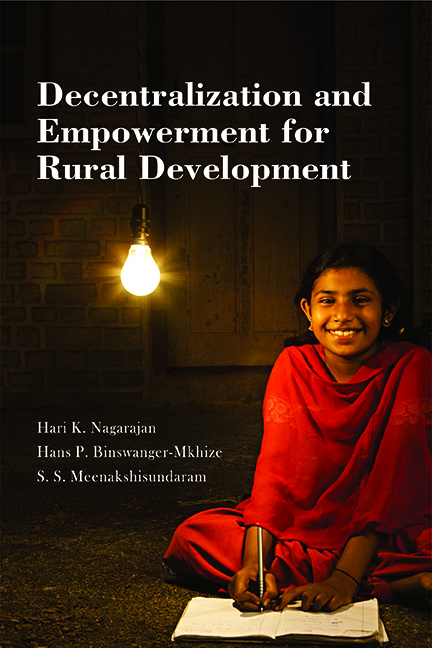Book contents
- Frontmatter
- Contents
- List of Tables and Figures
- Foreword 1
- Foreword 2
- Preface
- 1 Introduction
- 2 Decentralization: Cross-country Experiences
- 3 Thinking about Decentralization in India: 73rd Amendment and Beyond
- 4 Literature
- 5 An Overview of the Data
- 6 Analytical Approaches and Econometric Methods Used
- 7 Can Panchayats Improve the Quality of Services? Some Qualitative Evidence
- 8 Impact of Political Reservations for Women in Panchayats
- 9 Importance of Individual Empowerment of Women
- 10 Governance, Service Provision and Development Outcomes
- 11 The Impact of Fiscal Grants on Tax Efforts of Village Panchayats
- 12 Incidence of Identity-based Voting and Bribes in Panchayats
- 13 Panchayats and Household Vulnerability
- 14 Key Findings, Conclusions and Policy Recommendations
- References
- Index
- About the Authors
13 - Panchayats and Household Vulnerability
Published online by Cambridge University Press: 30 November 2022
- Frontmatter
- Contents
- List of Tables and Figures
- Foreword 1
- Foreword 2
- Preface
- 1 Introduction
- 2 Decentralization: Cross-country Experiences
- 3 Thinking about Decentralization in India: 73rd Amendment and Beyond
- 4 Literature
- 5 An Overview of the Data
- 6 Analytical Approaches and Econometric Methods Used
- 7 Can Panchayats Improve the Quality of Services? Some Qualitative Evidence
- 8 Impact of Political Reservations for Women in Panchayats
- 9 Importance of Individual Empowerment of Women
- 10 Governance, Service Provision and Development Outcomes
- 11 The Impact of Fiscal Grants on Tax Efforts of Village Panchayats
- 12 Incidence of Identity-based Voting and Bribes in Panchayats
- 13 Panchayats and Household Vulnerability
- 14 Key Findings, Conclusions and Policy Recommendations
- References
- Index
- About the Authors
Summary
Introduction
The policy of inclusive growth adopted by India as part of the Eleventh Five Year Plan puts a lot of emphasis on reducing poverty and vulnerability and significantly increased government expenditures on programmes, many of which involve implementation via panchayats or in association with them. More specifically the central government has put in place two flagship programmes that both transfer income and reduce the vulnerability of households to shocks, namely MGNREGA and the Food Security Act. Under MGNREGA the panchayats select works and implement them, as well as participating in the targeting of the employment benefits. This has put control over large amounts of resources under the control of the panchayats. In the Food Security Act they participate in the targeting of beneficiaries and also have some oversight responsibilities.
Could panchayats play an even bigger role in reducing vulnerability to shocks via the use of own revenues or untied grants? Would unequal access to services, improper usage of programmes, programme capture, bribes, and inefficiencies in programme delivery, be reduced if they did so? These are the questions pursued in this chapter.
First the impact of ex ante vulnerability on ex post poverty dynamics is examined. Then the components of vulnerability are identified so that policy can be more focused. Finally, the impact of coping strategies on vulnerability and destitution and on economic welfare of households is assessed. More specifically the chapter focuses on five questions.
Does gender of the elected representatives matter, which we assess by measuring the impact of political reservations on reducing vulnerability?
• What will be the impact of regime changes on resource reallocation and on household consumption? Are all types of regime changes (based on jati or gender) likely to have similar impacts on household vulnerability?
• Do households fall into a poverty trap, i.e., experience chronic poverty, due to inefficiencies associated with governance?
• Has local governance contributed to households undertaking less risky coping strategies in response to adverse shocks?
• During periods of distress, are local governments able to provide insurance through their interventions?
• After experiencing adverse shocks, is the insurance that the panchayats provide sufficient to eliminate the need for households to cut their food consumption to less than two meals, or to avoid selling of productive assets, and thereby reduce both vulnerability and poverty?
- Type
- Chapter
- Information
- Decentralization and Empowerment for Rural Development , pp. 294 - 332Publisher: Foundation BooksPrint publication year: 2014

